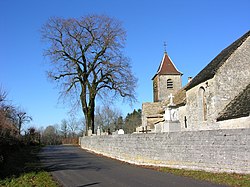Bonnefontaine (Jura)
| Bonnefontaine | ||
|---|---|---|
|
|
||
| region | Bourgogne-Franche-Comté | |
| Department | law | |
| Arrondissement | Lons-le-Saunier | |
| Canton | Poligny | |
| Community association | Bresse Haute Seille | |
| Coordinates | 46 ° 44 ′ N , 5 ° 45 ′ E | |
| height | 534-745 m | |
| surface | 8.80 km 2 | |
| Residents | 104 (January 1, 2017) | |
| Population density | 12 inhabitants / km 2 | |
| Post Code | 39800 | |
| INSEE code | 39065 | |
 Mairie Bonnefontaine |
||
Bonnefontaine is a commune in the French department of Jura in the region Bourgogne Franche-Comté . The municipality is the administrative seat of the Communauté de communes du Premier Plateau.
geography
Bonnefontaine is located at 582 m , about 16 kilometers east-northeast of the city of Lons-le-Saunier (as the crow flies). The farming village extends in the Jura , in the central part of the Plateau Lédonia (first Jura plateau), at the western foot of the Côte de l'Heute.
The area of the 8.80 km² large municipality covers a section of the French Jura. The main part of the area is taken up by the plain of the Plateau Lédonia, which lies at an average of 560 m and consists partly of arable land and meadow, partly of forest ( Bois du Chanay and Bois du Fuatelet ). The plateau has no above-ground watercourses because the rainwater seeps into the karstified subsoil. To the east, the community area extends over a relatively steep slope to the wooded ridge of the Côte de l'Heute , which separates the plateau from the Ain Valley to the east . The highest point of Bonnefontaine is reached on the ridge at 745 m .
The hamlet of Le Patouillet ( 577 m ) on the plateau at the western foot of the Côte de l'Heute belongs to Bonnefontaine . Neighboring communities of Bonnefontaine are Fay-en-Montagne and Picarreau in the north, Crotenay and Pont-du-Navoy in the east, Hauteroche with Mirebel in the south and La Marre in the west.
history
Traces of an Iron Age settlement have been found in the municipality of Bonnefontaine . The village was first mentioned in a document in the 12th century. Together with Franche-Comté , the village came to France with the Peace of Nijmegen in 1678. Until 1897 the municipality was called Les Faisses (derived from the Latin word fagus for beech ), after which it was renamed Bonnefontaine (based on the fountain).
Attractions
The Notre-Dame village church was built in 1486 on the site of a previous medieval building. Two side chapels and the current bell tower were added in the 18th century. Bonnefontaine also owns a manor house and various farmhouses in the traditional style of the 17th to 19th centuries.
population
| Population development | |
|---|---|
| year | Residents |
| 1962 | 141 |
| 1968 | 107 |
| 1975 | 86 |
| 1982 | 97 |
| 1990 | 98 |
| 1999 | 84 |
With 104 inhabitants (as of January 1, 2017) Bonnefontaine is one of the smallest municipalities in the Jura department. After the population had decreased markedly in the first half of the 20th century (206 people were still counted in 1896), only relatively minor fluctuations have been recorded since the mid-1970s.
Economy and Infrastructure
Bonnefontaine was a predominantly agricultural and forestry village well into the 20th century. In addition, there are now some local small businesses. In the meantime, the village has also turned into a residential community. Many workers are commuters who work in the larger towns in the area.
The village is located off the major thoroughfares on a departmental road that leads from Mirebel to Fay-en-Montagne. Other road connections exist with La Marre, Picarreau and Besain.

